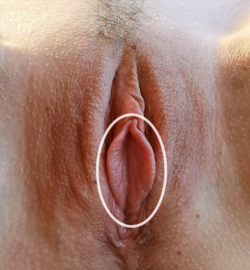| Labia minora | |
|---|---|
 Hairless human vulva with labia minora encircled between the rounded thicker outer labia majora. | |
| Details | |
| Precursor | Urogenital folds |
| Part of | Vulva |
| Identifiers | |
| Latin | labium minus pudendi |
| TA98 | A09.2.01.007 |
| TA2 | 3553 |
| FMA | 20374 |
| Anatomical terminology | |
The labia minora (Latin for 'smaller lips', sg.: labium minus), also known as the inner labia, inner lips, or nymphae,[1] are two flaps of skin that are part of the primate vulva, extending outwards from the inner vaginal and urethral openings to encompass the vestibule.[2] At the glans clitoris, each labium splits, above forming the clitoral hood, and below the frenulum of the clitoris. At the bottom, the labia meet at the labial commissure. The labia minora vary widely in size, color and shape from individual to individual.
The labia minora are situated between the labia majora and together form the labia. The labia minora are homologous to the penile raphe and ventral penile skin in males.[3][4]
- ^ nymphae Archived 2008-06-28 at the Wayback Machine. Dictionary.com. Merriam-Webster's Medical Dictionary. Merriam-Webster, Inc. (accessed: November 24, 2007).
- ^ Blüm, Volker (2012). Vertebrate Reproduction: A Textbook. Springer Berlin Heidelberg. p. 74. ISBN 978-3-64271-074-2. Retrieved November 19, 2023.
- ^ Hodges, Frederick Mansfield S.; Denniston, George C.; Milos, Marilyn Fayre (2007). Male and Female Circumcision: Medical, Legal, and Ethical Considerations in Pediatric Practice. Springer US. p. 10. ISBN 978-0-58539-937-9. Retrieved November 24, 2023.
- ^ Martin, Richard J.; Fanaroff, Avory A.; Walsh, Michele C. (2014). Fanaroff and Martin's Neonatal-Perinatal Medicine E-Book: Diseases of the Fetus and Infant. Elsevier Health Sciences. p. 1522. ISBN 978-0-32329-537-6. Retrieved November 24, 2023.